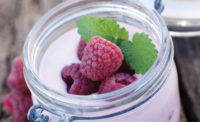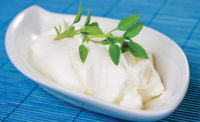It’s official: Americans’ love affair with sugar is over, and they’re breaking up en mass with their ol’ sweetie. In the International Food Information Council’s (IFIC) 2017 Food & Health Survey, 76% of respondents said they are trying to limit or avoid sugars in general, with six in 10 declaring that they view sugars negatively.
So it should come as no surprise that dairy manufacturers aiming to please these same consumers are reevaluating their relationships with the sweetener, and treading gingerly back into the dating pool in search of an alternative that meet everyone’s needs.
But if only finding a sugar alternative were as easy as online dating: Just set up a profile, list your desires and deal breakers, post a few photos of that cute fro-yo sundae or studly whey-protein smoothie you’re developing … and let the high-intensity, all-natural offerings flood your inbox.
Alas, any relationship worth having requires work. And the relationship among sweeteners, dairy products and the consumers who love them is worth working for. Fortunately, new sweetener ingredients are making “happily ever after” much easier to come by.
And today’s consumers set the bar high when it comes to sweeteners.
“While many want to limit or avoid sugars, [they] still expect the same irresistible sugar-like taste and experience,” said Veronica Cueva-Beach, vice president, global technology, specialty food ingredients for Tate & Lyle, Hoffman Estates, Ill. “In fact, consumers agree that a good balance of taste and health is the most important benefit of a sweetener.”
In other words, they want to have their ice cream cakes and eat them, too. And if the sweeteners in those cakes can be “natural,” more is better. Honey is one natural option.
“Despite how quickly perceptions are changing, we’re seeing a definite trend toward all-natural sweeteners,” noted Catherine Barry, director of marketing for the National Honey Board, Firestone, Colo. “If consumers are going to indulge in a sweetened beverage or dessert, they want to make sure they’re doing so with an all-natural product.”
The data bear her out. In its May 2015 “Sugar and Alternative Sweeteners — US” report, global market research firm Mintel notes that more than six out of 10 consumers say they want more natural sugar substitutes.
Shifting palates
While consumers might be perennially conflicted about sugar — besotted with its sweetness but wary of its health implications — it appears that some are actually shifting their palates and attitudes in a less-sweet direction.
“We’re seeing a growing number of innovative products explore more savory flavors, which brings new options for consumers to enjoy their preferred dairy products,” said Ivan Gonzales, marketing director, dairy for Ingredion Incorporated, Westchester, Ill.,
Wade Schmelzer, principal scientist for Cargill, Minneapolis, has also noted the shift — on the part of both consumers and dairy manufacturers.
“Without question, taste still drives sales,” he noted. “That said, we’ve seen dairy customers exploring opportunities to reign in sugar content — not just in terms of sugar reduction, but also in the development of less-sweet alternatives. In yogurts, for example, we’ve seen products like Icelandic yogurt, with more sourness and less sweetness.”
All in good taste
But sweetness still reigns supreme in many dairy applications. And for sweetening power, sugar still comes out on top.
As Vince Cavallini, beverages, snacks and cereals application manager for Cargill, put it, “We often think of sugar as the gold standard of sweetness. After all, everyone knows what sugar tastes like. Sugar has a relatively quick onset with a high-quality, rounded middle sweetness and minimal lingering aftertaste.”
You can’t say the same for high-intensity sweeteners, which have very different qualities and sweetness onsets — and often bring with them lingering aftertastes that are absent in sugar.
“While sugar alcohols like erythritol don’t have the lingering taste of high-intensity sweeteners, their sweetness tends to be light,” noted Hideki Fujihara, manager of the dairy application team for Matsutani Chemical Industry Co. Ltd., Chicago.
Beyond sweetness, sugar contributes sensory qualities that its imitators don’t.
“For refrigerated and frozen dairy applications, how sugar dissolves and melts, in addition to the mouthfeel and texture it provides, is also quite unique,” explained Ben George, senior food scientist – dairy for Kerry, Beloit, Wis.
Alternatives such as sugar alcohols and non-nutritive high-intensity sweeteners may deliver the same upfront and back-end sweetness, he noted, but matching the “very balanced sweetness profile of sugar” is often a significant challenge.
“There can also be challenges with peaky off notes and the aftertaste of these sweetener options,” George said. “So it can, therefore, be challenging to match the taste and functionality sugar delivers.”
Multiple tools in the box
Sugar and nutritive ingredients such as corn syrup solids, high fructose corn syrup, glucose, lactose and even whey have long contributed to functionality and taste in dairy products, George said.
“Sugar acts as a bulking agent that’s easy to handle, mix and dissolve,” he said. “It impacts mouthfeel and viscosity and how frozen desserts and ice cream freeze and thaw. It can also react with protein when heated, for example, to produce more complex caramel flavors and textures in frozen desserts and dairy beverages.”
All of which means that finding a substitute to cover all those bases remains a dairy developer’s dream.
As Schmelzer put it, “No single ingredient can provide all the functionality of sugar. As a result, dairy product formulators will likely need to use multiple tools in the ingredient toolbox to create a successful reduced-sugar product. Fortunately, product developers are equipped with more options than ever.”
Turning over a new leaf
George agreed, particularly in regard to “natural” sugar alternatives.
“The move from artificial non-nutritive sweeteners such as sucralose to natural non-nutritive sweeteners such as stevia and monk fruit has helped significantly,” he said. “There have been significant developments in the taste profile, aftertaste and consistency of these natural ingredients, resulting from greater availability, improved quality controls and purification technologies.”
In fact, the stevia ingredients of today are nothing like those that came before — and it seems as if every supplier has its own advanced technology to tout.
Rebaudioside A, which was the most abundant molecule in the conventional variety of stevia leaf used at the time, was also the main steviol glycoside appearing in products designed to replace sugar. Yet developers soon learned that on its own, the glycoside’s strong bitter taste significantly limited its ability to achieve real sugar reductions.
“It’s still a fantastic ingredient and works well in reduced-sugar products,” noted Faith Son, vice president, marketing and innovation for PureCircle, Oak Brook, Ill. “But to truly take the leap forward, we went back to the leaf and discovered that there are dozens of different molecules there. When used in varying combinations, they can create a great sugar-like taste in low- to zero-calorie products.”
Using conventional crossbreeding practices, PureCircle even cultivated a variety called StarLeaf that has 20-plus times the sugar-like content of stevia leaf varieties.
Ingredion has fiddled with the stevia leaf’s glycosides, too, and its BESTEVIA Reb M, made through a partnership with SweeGen Inc., has brought a 95% purity Reb M to market.
“This new stevia leaf sweetener provides a sugar-like sweetness and has a high sweetness concentration combined with little to no bitter aftertaste,” said Afrouz Naeini, senior marketing manager – sweetness and beverage for Ingredion. “This makes it a great tool for formulators who want to reach higher levels of sugar reduction without negatively impacting the taste profile of their dairy products.”
Next-generation stevias — such as those in Cargill’s ViaTech line that use a taste-prediction model to predict precisely which combination of steviol glycolsides delivers optimal taste and sweetness — make noteworthy sugar reductions possible. So while a 2% to 3% sugar replacement in chocolate milk was possible using traditional stevia extracts, Schmelzer said, ViaTech products allow for the replacement of more than 6% sugar, without compromising taste.
“In dairy, stevia is often paired with the sugar alcohol erythritol,” Schmelzer pointed out. “This natural, zero-calorie bulk sweetener helps mask the aftertaste sometimes associated with high-intensity sweeteners, and in frozen dairy desserts can also restore the freezing-point depression sugar provides.”
And that’s no small matter. Sugar, when dissolved in an ice cream or frozen dairy mixture, lowers the mixture’s freezing point below zero, preventing the formation of large ice crystals and creating the smooth, creamy texture we’ve grown to crave in ice cream. High-intensity sweeteners used at very low concentrations can’t achieve this trick.
“Because of its small molecular size — one third that of sugar — erythritol can fill that void, providing a threefold freezing-point depression factor,” said Ravi Nana, polyols technical service manager for Cargill. “That higher effect on freezing-point depression helps soften reduced-sugar ice creams, creating the scoopable texture consumers expect.”
Bulking up
Erythritol can also restore formulation bulk that’s lost when sugar levels drop.
“Remove 1 pound of sugar and you need to put 1 pound of something back into the formula,” Nana explained. “As a zero-calorie bulk sweetener, erythritol replaces sugar at a one-to-one ratio, without adding to the calorie count.”
Another bulk sugar replacement that brings added benefits is chicory root fiber — marketed under various trade names, including Cargill’s Oliggo-Fiber.
“Mildly sweet in its own right, chicory root fiber can help modulate the flavor of some high-intensity sweeteners,” noted Pam Stauffer, global marketing programs manager for Cargill. “It even offers benefits to reduced-fat dairy applications, mimicking the texture of fat and giving added richness and improved mouthfeel.”
Even better, chicory root fiber is a soluble fiber, making its use a strategy for “smart sugar reduction,” said Jon Peters, president of Beneo Inc., Parsippany, N.J. It replaces the sweetener with a healthful, prebiotic ingredient that encourages satiety while triggering a low glycemic response.
Beneo trials found that its Orafti Oligofructose brand of chicory root fiber boosts sweetness, mouthfeel, body and fruit flavor in fruit yogurt while allowing for a 20% reduction in total sugar and a 35% reduction in added sugar.
“Following a variety of trials, we found that the best reduced-sugar formulation combined sugars, oligofructose and a sweetness-enhancing flavor while avoiding the use of any high-potency sweeteners,” Peters said.
Further, chicory root fiber helps solve the perennial chocolate-milk problem.
“As school lunch programs push to reduce sugar,” Peters explained, “chicory root fiber is an excellent solution because it’s adding sweetness while adding prebiotic soluble dietary fiber in a natural way. Additionally, you’re adding a health-promoting ingredient while maintaining texture.”
Rare treat
Another possible replacement for sugar’s bulk: allulose. This monosaccharide is a “rare” sugar that occurs naturally in some fruits and vegetables. But the body doesn’t recognize it as a carbohydrate; thus, it harvests only 0.2 kilocalories/gram from it. And yet allulose looks, performs and tastes like sugar, albeit at roughly 70% the sweetness.
In the mid-1990s, Ken Izumori, a professor at Japan’s Kagawa University, developed a process — appropriately named “Izumoring” — that, through reaction with a microbial enzyme, causes sugars to change from one form into another.
“A wide variety of high-quality rare sugars can be made this way,” Fujihara said.
One of them is Matsutani’s Astraea allulose.
Another brand of allulose on the market is Tate & Lyle’s Dolcia Prima, which Cueva-Beach said offers many of the same benefits as sucrose in frozen desserts. Because its effect on freezing point is very similar to that of caloric sugars, it helps forestall the formation of ice crystals.
“And it adds creamy mouthfeel, smooth texture, balanced sweetness, a good meltdown and similar levels of bulk to that of sucrose,” she said.
Having waited years to add it to his company’s sweetener portfolio, Thom King, president and CEO of Icon Foods, Portland, Ore., is happy to see allulose on the scene.
“We have mostly been focused on frozen dairy desserts where we’re addressing clean-label sugar reduction, and our biggest challenges have been mouthfeel,” he said. “Our allulose stevia monk fruit blend has addressed a lot of the challenges effectively. And our allulose and stevia combo really addresses texture through depression point and stability. This will be a major game changer.”







